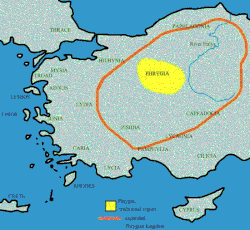
Back Frigië Afrikaans ፍርግያ Amharic فريجيا Arabic Frixa AST Frigiya Azerbaijani Фригия Bashkir Фрыгія Byelorussian Фрыгія BE-X-OLD Фригия Bulgarian Frygia Breton
Kingdom of Phrygia 𐊩𐌏𐌛𐊅𐊄𐌌 Gordum | |||||||||||||||
|---|---|---|---|---|---|---|---|---|---|---|---|---|---|---|---|
| 1200–675 BC | |||||||||||||||
 Map of the Phrygian Kingdom at its greatest extent, c. 700 BC. | |||||||||||||||
| Capital | Gordion | ||||||||||||||
| Common languages | Phrygian | ||||||||||||||
| Religion | Phrygian religion | ||||||||||||||
| Government | Monarchy | ||||||||||||||
| Kings[a] | |||||||||||||||
| Gordias | |||||||||||||||
| Midas | |||||||||||||||
| Historical era | Iron Age | ||||||||||||||
| 1200 BC | |||||||||||||||
| 675 BC | |||||||||||||||
| |||||||||||||||
| Part of a series on |
| Indo-European topics |
|---|
 |
In classical antiquity, Phrygia (/ˈfrɪdʒiə/ FRIJ-ee-ə; Phrygian: 𐊩𐌏𐌛𐊅𐊄𐌌,[6] romanized: Gordum; Ancient Greek: Φρυγία, Phrygía) was a kingdom in the west-central part of Anatolia, in what is now Asian Turkey, centered on the Sangarios River. After its conquest, it became a region of the great empires of the time.
Stories of the heroic age of Greek mythology tell of several legendary Phrygian kings:
- Gordias, whose Gordian Knot would later be cut by Alexander the Great
- Midas, who turned whatever he touched to gold
- Mygdon, who warred with the Amazons
According to Homer's Iliad, the Phrygians participated in the Trojan War as close allies of the Trojans, fighting against the Achaeans. Phrygian power reached its peak in the late 8th century BC under another historical king, Midas, who dominated most of western and central Anatolia and rivaled Assyria and Urartu for power in eastern Anatolia. This later Midas was, however, also the last independent king of Phrygia before Cimmerians sacked the Phrygian capital, Gordium, around 695 BC. Phrygia then became subject to Lydia, and then successively to Persia, Alexander and his Hellenistic successors, Pergamon, the Roman Empire and the Byzantine Empire. Over this time Phrygians became Christian and Greek-speaking, assimilating into the Byzantine state; after the Turkish conquest of Byzantine Anatolia in the late Middle Ages, the name "Phrygia" passed out of usage as a territorial designation.
Cite error: There are <ref group=lower-alpha> tags or {{efn}} templates on this page, but the references will not show without a {{reflist|group=lower-alpha}} template or {{notelist}} template (see the help page).
- ^ Rose, C. Brian; Darbyshire, Gareth, eds. (2011). The New Chronology of Iron Age Gordion. Philadelphia: University of Pennsylvania Museum.
- ^ Liebhart, Richard; Darbyshire, Gareth; Erder, Evin; Marsh, Ben (2016). "A Fresh Look at the Tumuli of Gordion". In Henry, Olivier; Kelp, Ute (eds.). Tumulus as Sema: Space, Politics, Culture and Religion in the First Millennium BC. De Gruyter. pp. 627–636.
- ^ Sulimirski & Taylor 1991, p. 559.
- ^ Ivantchik 1993, p. 57-94.
- ^ Olbrycht 2000a.
- ^ Obrador Cursach, Bartomeu (2018). Lexicon of the Phrygian Inscriptions (PDF). Doctoral dissertation, Universitat de Barcelona. pp. 31–50. Retrieved 6 July 2021.
© MMXXIII Rich X Search. We shall prevail. All rights reserved. Rich X Search